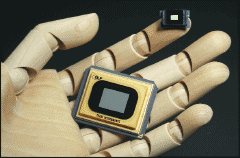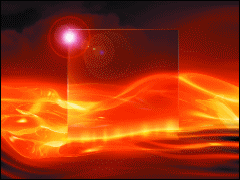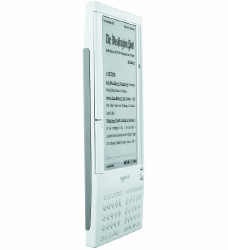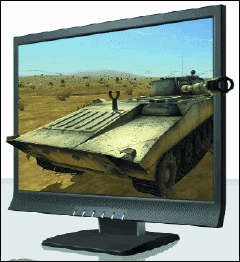2009 Display of the Year Award Winners
The SID Display of the Year Awards Committee selected six winners – in the categories of display of the year, display component of the year, and display application of the year – that advanced the state of the art of electronic-display technology in 2008.
by Jenny Donelan
IF THERE IS A COMMONALITY among the six winners of the SID/Information Display Display of the Year Awards this year, it is that they take existing technology to new levels. "The general trend," says Dick McCartney, SID's Display of the Year Committee Chair, "is an increasing sophistication of display performance that enables wholly new applications." An example, he says, is the Display Application of the Year winner, Amazon's Kindle. "Here is a way of reading books that might have been thought of as science fiction just a few years ago that is now being enabled through display technology," says McCartney. Similarly fantastic-seeming is the way that Texas Instruments reduced a chip containing thousands of micro-mechanical mirrors to a footprint smaller than a U.S. dime. The DLP Pico Chipset from TI, the Silver Award winner for Display of the Year, creates enlarged (and therefore more visible and useful) imagery from small-screen mobile displays.
The Pico Chipset is actually one of three winners this year that provide support for mobile devices. Corning's Jade fusion glass, the Gold Award winner for Display Component, is optimized for the more demanding processes necessary to create today's mobile devices. And Merck's PS-VA mixtures, the Silver Award winner in the component category, reduces backlight power consumption for LCDs, thus enabling longer-lasting battery life in mobile devices and more energy-efficient TVs.
One of the most striking examples of taking technology to the next level is the Display of the Year Gold Award winner, Samsung's 240-Hz LCD-TV panel. LCDs have evolved exponentially in every way – except that motion-image performance is still a stumbling block. Samsung's technology, however, overcomes that stumbling block, thus helping LCD TV to achieve its full potential. And the Silver Award winner in the Display Application category, the iZ3D monitor, uses liquid-crystal technology in a new way to bring the types of 3-D applications that are becoming mainstream in movie theaters into the home.
These products will be honored at a ceremony during the annual SID Luncheon, which takes place on June 3 during Display Week in San Antonio, Texas. During the ceremony, the three 2009 Gold Award winners will each present a short video about the winning product. Tickets for the luncheon cost $35 each and can be obtained at www.sid2009.org or at the show registration desk prior to June 3.
The award-winning displays, components, and applications are described as follows, based on information supplied by the winning companies.
Display of the Year
This award is granted for a display with novel and outstanding features such as new physical or chemical effects, or a new addressing method.
Gold Award: Samsung's 240-Hz LCDs
Samsung has broken new ground with the introduction of its 40-, 46-, and 52-in.-diagonal full-high-definition (FHD, 1020 x 1080) 240-Hz LCD panels. These panels deliver unprecedented motion-image performance for LCD TVs, enabling superlative image quality even for fast-action high-speed moving images. Recent increases in LCD resolution, luminance, contrast ratio, viewing angle, color gamut, and color depth have all brought LCD-TV picture quality to new levels, but motion-image performance has been widely considered to be the final obstacle between LCD TV and the ultimate viewing experience. Samsung's 240-Hz LCD panels have now removed that obstacle with a highly innovative pixel-cell structure and a new driving architecture that overcomes hold-type driving limitations inherent in LCDs and other matrix-addressed displays.
NTSC video streams provide a new frame of data 60 times per second. In Samsung's new 240-Hz panels, a motion-estimation motion-compensation (ME/MC) engine creates three interpolated frames for every one incoming frame. The three interpolated frames are inserted between each two incoming frames. Therefore, the viewer sees four times as many frames as with conventional TV, which reduces by a factor of 4 the frame-to-frame image-holding time that causes motion blur.
Motion performance of displays is characterized using the motion-picture response-time (MPRT) metric. LCDs refreshed at 60 Hz typically deliver MPRT values at about 16 msec. This level of MPRT performance results in significant motion blur for fast-moving image sequences, especially on larger screens. In 2007, Samsung was first to market with 120-Hz panels, delivering MPRT scores of 7–8 msec, similar to that of plasma-display-panel (PDP) screens. Samsung's new 240-Hz panels deliver MPRT results on the order of 4 msec, which is a performance level comparable to that of a CRT. This type of "CRT-like" motion-image performance was previously considered unattainable on LCDs and other matrix-addressed displays.
Since the first showing of Samsung's panels at the IFA show in August 2008, other manufacturers have released pseudo-240-Hz panels that are based on a combination of 120-Hz driving and backlight blinking. Unlike those products, Samsung's panels actually update the pixel data values 240 times per second. This "true 240-Hz" design approach avoids ghosting images and other display artifacts that have been associated with the hybrid techniques.
Key technologies that enable Samsung's 240-Hz system include an advanced ME/MC interpolation architecture, new embedded-clock interface technologies to handle the higher data bandwidth between the timing controller and source boards, a new LCD panel architecture based on half-gate double-data (hG-2D) driving, and a novel pixel structure based on charge-shared super-patterned ITO vertical alignment (CS S-PVA). Samsung's CS S-PVA structure is a key enabling technology that effectively doubles the available pixel charging time, in turn allowing the 240-Hz panel's data lines to be driven cost effectively with a single bank of column drivers.
Samsung commenced mass production of its 240-Hz panels in September, 2008. Initial TV-system shipments commenced in Q4 '08. Further technical details will be presented at Display Week 2009 in San Antonio, where one of the 240-Hz panels will be on display.
Silver Award: Texas Instruments' DLP Products – DLP Pico Chipset
Texas Instruments DLP Products has developed a way of offering large-scale viewing of the increasing amount of mobile content consumers have at their fingertips with the first generation of the DLP Pico Chipset. This new technology is so small that device manufacturers can embed DLP projectors into mobile phones and accessories, enabling enhanced viewing on the go. DLP pico technology allows users to project enlarged images, video, and Web browsing onto any flat surface. A coffee shop becomes a boardroom, a camping tent becomes a theater, and the classroom wall transforms into the newest backdrop for share-and-tell.
By utilizing unconventional light sources such as LEDs, DLP pico technology features an aperture ratio of more than 92%, tens of thousands of pixel elements, switching speeds of less than 20 μsec, and TI's DarkChip native-contrast-ratio process technology. In addition, the chipset is capable of displaying the widest color gamuts possible. Images are produced using the same technology that goes into all DLP products. Over 100,000 tiny hinge-mounted mirrors are used to project up to 50-in. diagonally in size.
The initial concept for DLP pico technology emerged about 3 years ago. With a value proposition of projecting the biggest image from the smallest box, an opportunity to expand into new categories became apparent. The DLP team looked at cell phones, handhelds, and laptops and identified limitations in screen size and viewing capabilities. For example, when checking e-mail from a smart phone, users cannot see an attachment.
The first-generation DLP Pico Chipset can be found in mobile devices, handhelds, portable media players, and notebook companions. Leading brands including Samsung, Optoma, Dell, and others have already launched products based on this technology, with additional hardware manufacturers bringing new implementations to market later this year.
Looking ahead, Texas Instruments is in a unique position to impact the future of the mobile industry with DLP pico technology by transforming individual to shared viewing environments. Whether for work or play, DLP pico technology enhances the way consumers view and digest content. The boundaries are virtually limitless, with opportunities in the health and education industries as well as entertainment.
|
DISPLAY OF THE YEAR
|
|

Gold Award: Samsung's 240-Hz LCD-TV panels enable groundbreaking motion-image performance that was heretofore unavailable in LCD-TV technology. The viewer sees four times as many frames as with pre-existing TVs, which has the effect of reducing by a factor of 4 the frame-to-frame image-holding time that causes motion blur. Image courtesy Samsung.
|

Silver Award: The first-generation DLP Pico Chipset from TI incorporates more than 100,000 microscopic, hinge-mounted mirrors that can project up to 50-in. diagonally in size, thus enabling enlarged viewing for a wide variety of mobile devices. Shown here is the conventionally larger DLP imager (bottom) capable of over 1 million mirrors compared to the new miniature DLP imager (top). Image courtesy Texas Instruments.
|
Display Component of the Year
This award is granted for a novel component that has significantly enhanced the performance of a display. A component is sold as a separate part destined to be incorporated into a display. A component may also include display-enhancing materials and/or parts fabricated with new processes.
Gold Award: Corning's Jade Glass for Advanced Display
In January 2008, Corning launched Jade glass for advanced display, a fusion-formed glass with high thermal stability, designed for the high-end feature-rich mobile-device market. Jade works with two display technologies – low-temperature polysilicon (LTPS) applications and organic light-emitting diodes (OLEDs) – to solve some of the challenges facing the mobile-device industry. Jade is the first glass substrate optimized for LTPS. Beyond this application, Jade provides capabilities that may enable the scaling of OLEDs to large-sized TVs.
The amorphous-silicon (a-Si) process is used in the manufacture of LCDs for TVs and monitors, while the LTPS process is used by makers of displays for small devices. Compared to a-Si, the LTPS process is much more demanding in terms of temperature, surface, and dimensional requirements, and while it may seem a contradiction to talk about a high- thermal-capability glass for a process described as "low temperature," that is precisely what is needed. The LTPS process requires the glass to be very stable and not change shape. Throughout the process, the glass must also maintain a pristine surface quality. The keys are uniformity and consistency.
The primary distinction between Jade and other polysilicon glasses is that Jade needs no secondary heat treatment or polishing to meet the demanding surface and thermal stability requirements of the LTPS and OLED manufacturing processes. Previously, fusion manufacturers (including Corning) needed to heat-treat a-Si glass in order to stabilize it so that it could withstand the process – in effect, pre-shrinking the glass. Not only does this pre-treatment make the entire process more complex, it also creates the potential for the glass to change shape under high temperature, and the extra handling can degrade the surface quality of the glass.
Furthermore, if the glass was made using the float process rather than fusion, it would also need special polishing to ensure the extraordinary surface-quality demands of the polysilicon backplane. Corning knew that these extra steps could be eliminated by developing a new composition for fusion manufacturing applications. Eliminating the heat treatment preserves the benefits of a fusion-formed-glass pristine surface, excellent control of thickness and shape, flexible capacity, and reliable supply.
The end result is that Jade permits the tighter design rule needed for increased integration of electronic functionality onto the glass. For device makers, this type of component integration means lower cost and increased design flexibility; for consumers, the end result is more-compact devices with brighter displays, higher resolution, and longer battery life.
In addition to its benefits for LTPS-LCD, Jade provides the superior surface and thermal stability required for OLED displays. One of the major technical challenges slowing the growth of the OLED industry has been polysilicon backplane performance. Because OLEDs are current-driven devices, they require a backplane with much higher performance than a conventional LCD. There are at present a number of new and exciting approaches to scaling polysilicon backplane technology for the particular requirements of OLEDs to large-sized TV. Some use microcrystalline-silicon technology. Others use new types of laser technology. What all these potentially scalable processes have in common is the need for high-temperature capability from their substrate. Jade gives customers process flexibility that can help them achieve optimized backplane performance for OLEDs.
Polysilicon has always had the promise to deliver higher-performance devices, but the limitations of LTPS technology have confined it to a small portion of the marketplace. Jade will now help move LTPS technology forward, providing increased flexibility for innovation in performance and scalability.
Silver Award: Merck's PS-VA Mixtures
Polymer-stabilized vertical-alignment (PS-VA) is a novel LCD technology that enables displays with very fast switching and very high contrast, as well as high transmission. Thus, backlight brightness can be significantly reduced, which prolongs battery lifetime in mobile devices and reduces power consumption in TV sets – making both these products "greener." Lower backlight power, as well as the PS-VA-specific LCD-electrode layout, also provide a cost benefit to LCD makers.
PS-VA technology needs very specific LC mixtures and also a specific panel-manufacturing process: in the PS-VA mixture, a small amount of polymerizable LC (reactive mesogen) is the key component. During the PS-VA process step at the panel manufacturer, that reactive mesogen is polymerized by UV light while a voltage is applied to the LCD panel. For well-chosen liquid-crystal mixture formulations, display layouts, and process conditions, a local, small deviation of the LC orientation from the vertical direction, or "tilt," is generated, which brings about the above-mentioned significant enhancements in LCD performance.
From a practical point of view, incorporating a tiny, but well-defined amount of reactive mesogen into an LC mixture is not a trivial matter, as modern displays demand the utmost purity in all materials. "Normal" LCs are basically inert, but due to the reactivity of the new component, special large-scale LC-mixture production processes and equipment as well as new quality-control methods need to be employed (while also minimizing any drawbacks in takt time and yield).
The PS-VA display principle was developed several years ago, and Merck was deeply involved in the creation of suitable materials from the beginning. Since PS-VA needs specific reactive mesogens, Merck's long-running activities with regard to reactive mesogens for optical compensation films were an important basis for this development – both from a physics as well as a chemistry point of view. Significant challenges had to be overcome in the field of materials as well as in the LCD panels, and only quite recently have PS-VA panels begun entering the market. In all cases, specifically developed innovative materials from Merck were an important key to the success.
In these first commercial products, the flexibility of the PS-VA concept has clearly been used for the optimization of very different LCD performance parameters: ultimate resolution in mobile phones, high contrast and color saturation in portable gaming devices, and ultimate static contrast in TVs. The basic strength of PS-VA is the new degree of freedom it gives to LCD design and layout – thus allowing for new solutions beyond the standard LCD modes. There is more to come, and Merck is very active in developing materials for today's and future requirements.
|
DISPLAY COMPONENT OF THE YEAR
|
|

Gold Award: Jade fusion glass from Corning is the first glass substrate optimized for LTPS applications, which are critical for makers of small devices such as mobile phones. Image courtesy Corning.
|

Silver Award: Merck's PS-VA mixtures enable a new LCD technology that reduces backlight power, ultimately reducing power consumption for both mobile devices and TVs. Image courtesy Merck.
|
Display Application of the Year
This award is granted for a novel and outstanding application of a display, where the display itself is not necessarily a new device.
Gold Award: Amazon.com's Kindle 1
The Amazon Kindle is a revolutionary portable reader that wirelessly downloads books, blogs, magazines, and newspapers to a crisp, high-resolution electronic-paper display that is designed to look and read-like real paper, even in bright sunlight. Kindle uses a display technology called electronic paper that provides a sharp black-and-white screen that works by using ink, just like books and newspapers, but displays the ink particles electronically. It reflects light like ordinary paper and uses no backlight, which helps eliminate the eyestrain and glare associated with other electronic displays such as computer monitors or PDA screens.
When Amazon began the Kindle project, "we knew that we had set an audacious goal for ourselves," writes the company. "The book has been a technological stalwart since the first century and despite many attempts, there has not been another portable reader that made reading digital books better than reading physical books. If we were going to be successful, we knew that we could not try to 'outbook' the book – we had to take everything we love about books and add breakthrough conveniences. The number-one design goal for Kindle was to make it disappear. We wanted people to become so engrossed by the story within that they forget they are reading on a device." Amazon therefore created the following requirements for the project:
• Kindle had to have ubiquitous wireless access – when customers anywhere in the U.S. thought of a book, they needed to be able to have it in a minute. So Amazon built its own wireless delivery system, Amazon Whispernet, to make that possible.
• It had to offer an engrossing reading experience to make people forget they were reading on a device. According to Amazon, "we gave Kindle an electronic-paper screen that reads like real paper and a design that makes it easy to hold and navigate for long-form reading."
• Kindle could not limit people's reading options – it had to expand them. Amazon made it a complete reading device for books, newspapers, magazines, and blogs, and stocked the Kindle Store with over 260,000 book titles.
• The device had to be simple and hassle free. It requires no PC, software installation, or syncing. Kindle also has no monthly wireless bills, 2-year commitments, or service plans.
Amazon's stated goal is to offer the world's best purpose-built reading device. The company's long-term vision for Kindle is to have every book ever published, in any language, in print or out of print, all available in less than 60 sec. It started out with 90,000 available books in 2008 and today offers over 260,000 books, plus newspapers, magazines, and blogs.
|
The Story Behind Electronic Paper
|
|
The electronic-paper display used by the Kindle is a proprietary material developed by E Ink Corp. that is processed into a film (called E Ink Vizplex) for integration into electronic displays. The principal components of E Ink Vizplex are millions of tiny microcapsules, about the diameter of a human hair. Each microcapsule contains positively charged white particles and negatively charged black particles suspended in a clear fluid. When a negative electric field is applied, the white particles move to the top of the microcapsule where they become visible to the user. This makes the surface appear white at that spot. At the same time, an opposite electric field pulls the black particles to the bottom of the microcapsules where they are hidden. By reversing this process, the black particles appear at the top of the capsule, which now makes the surface appear dark at that spot.
E Ink's Vizplex is ideally suited for e-books such as the Kindle, as it is a reflective technology that requires no front or backlight, is viewable under a wide range of lighting conditions, including direct sunlight, and requires no power to maintain an image.
– Information Display Staff
|
Silver Award: iZ3D's 3-D Monitor
In 2005, Neurok Optics decided that the autostereoscopic solutions it had been developing for monitors lacked the necessary "wow" factor for users. But the company was eager to attract a U.S. game-playing population of 100 million and encouraged by the increasing number of 3-D game titles on the market. It therefore made the decision to compromise its original goal of unaided 3-D viewing with the idea that consumers would find it preferable to wear some vision aid that enabled a 3-D "wow" factor as opposed to autostereoscopic 3-D with limited 3-D effects. Neurok then used the intrinsic electro-optical characteristics of liquid crystals to create its "iZ3D" technology with stacked panels in which liquid-crystal material acts as a polarized light-directing valve.
The software algorithm of iZ3D's polarization-based technology creates slightly different images for the left and right eye. But unlike film with fixed polarizer angles for projectors, iZ3D controls left- and right-eye images by dynamically changing the polarity of each picture element (pixel). Left- and right-eye images are addressed and controlled simultaneously. With the software-based iZ3D image-control algorithm, the back TFT-LCD controls the intensity of the transmitted light and the front TFT-LCD controls the polarization angle of the transmitted light. In actuality, iZ3D updates images 60 times per second. However, the change to the required polarization angle is performed subpixel by subpixel. That means that for 1680 x 1050 resolution, up to 600 million subpixels are reoriented every second for each image frame change. The polarizer films on the back LCD panel determine the polarizer axis of the light as it enters the front panel. To dynamically control the light transmission of the back and the front panel, iZ3D takes advantage of liquid crystal's inherent polarizing characteristics: the liquid crystal of the front panel redirects the entering polarized light, according to the degree of the liquid-crystal twist. To control the liquid-crystal twist, an electrical field is applied. Varying the electric field, subpixel by subpixel, results in polarization angle changes for each subpixel. The specific liquid-crystal material in iZ3Ds will respond to electrical-field changes with changes in the polarization angle anywhere between 45 and 135°. This method of simultaneously addressing, controlling, and displaying left- and right-eye images creates flicker-free images for comfortable, prolonged 3-D viewing enjoyment.
One obstacle the design team encountered was that stacking TFT panels results in ~95% light loss. Neurok overcame this barrier, however, by working with engineers at Chi Mei Optoelectronics (CMO) to eliminate polarizers and color filters from the front LC panel. With this breakthrough, light efficiency, cost reduction, reliability, and viewing quality were enabled. CMO and Neurok Optics then formed a joint-venture company, iZ3D, to produce 3-D monitors.
The 22-in.-wide iZ3D monitor is a 2-D/3-D switchable display bundle that includes passive 3-D glasses and stereoscopic 3-D display drivers. The monitor is designed for work in 2-D and for single- and multiple-player gaming in 3-D. Watching 3-D movies and videos is also supported with the addition of a software stereo player. The LCD panels feature a 16:9 aspect ratio with 1680 x 1050 resolution, 300-nit luminosity, and 5-msec response time. Inputs are dual-video DVI/DVI or DVI/VGA to drive the two stacked LCD panels. The monitor works with all current graphic cards that have dual outputs.
Currently, more than 300 electronic games are available in 3-D and new 3-D movies are being released with increasing frequency. In the future, the company plans to produce larger iZ3Ds to help usher 3-D into the consumer-electronics market space. •
|
DISPLAY APPLICATION OF THE YEAR
|
|

Gold Award: Amazon's Kindle uses electrophoretic display technology that helps users enjoy the experience of reading digital content in a unique, lightweight form factor with very long battery life. Image courtesy Amazon.
|

Silver Award: The iZ3D monitor leverages LCD technology to offer home users flicker-free imagery for comfortable prolonged 3-D viewing. Image courtesy iZ3D.
|
Jenny Donelan is the Managing Editor of Information Display
Magazine. She can be reached at jdonelan@pcm411.com